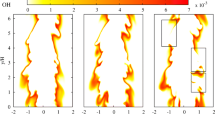Abstract
The noise generation of turbulent flames is governed by temporal changes of the total flame volume due to local heat release fluctuations. On the basis of the wave equation an expression for the relationship between the acoustic power and the heat release fluctuations is derived and a correlation function is obtained which reveals that the sound pressure level of flames is governed by the spatial coherence. Noise models rely on precise coherence information in terms of characteristic length scales, which are the measure of the acoustic efficiency of the flame. Since the published length scale information is scarce and inconsistent, length scales were measured for a number of laboratory flames using two measurement techniques developed for this purpose: A planar LIF-system with a repetition rate of 1 kHz acquires the instantaneous flame front position and heat release, whereas two chemiluminescence probes with an optics confining the measurement volume to a line of sight provide further spatial correlation data. For all flames investigated the length scales are smaller than the height of the burner exit annulus and they are of the order of the local flame brush thickness. Using the measured length scales, the coherent volume and the efficiency of the noise generation are calculated, which are three orders of magnitude higher than measured. However, the proper order of magnitude is obtained, if only the measured fluctuating part of the thermal power is used in the model and if the periodic formation of local zones with heat release overshoot and deficit are properly incorporated.
Similar content being viewed by others

Explore related subjects
Discover the latest articles and news from researchers in related subjects, suggested using machine learning.References
Lighthill, M.J., On sound generated gerodynamically. Part I. General theory. Proceedings of the Royal Society of London, Series A. Mathematical and Physical Sciences, London 211 (1952) 564–587.
Proudman, I., The generation of noise by isotropic turbulence. Proceedings of the Royal Society of London, Series A. Mathematical and Physical Sciences, London 214 (1952) 119–132.
Ribner, H.S., Quadrupole correlation governing the pattern of jet noise. J. Fluid Mechan. 38(1) (1969) 1–24.
Smith, T.J.B. and Kilham, J.K., Noise generation by open turbulent flames. J. Acoust. Soc. Am. 35(5) (1963) 715–724.
Strahle, W.C., On combustion generated noise. J. Fluid Mechan. 49(2) (1971) 399–414.
Clavin, P. and Siggia, E.D., Turbulent premixed flames and sound generation. Combust. Sci. Technol. 78 (1991) 147–155.
Klein, S.A., On the acoustics of turbulent non-premixed flames. Dissertation, University Twente, (2000) FEBO Druk, Enschede. ISBN 90-375 14096.
Sattelmayer, T., Hirsch, C., Krasznai, N., Wäsle, J. and Winkler, A., Lärmerzeugung von Drallflammen: Charakteristika und Modellierung. BMBF Workshop, Turbulenz in der Energietechnik, Aachen (2004).
Boineau, P., Gervais, Y. and Morice, V., An Aerothermoacoustic model for computation of sound radiated by turbulent flames. 25th Anniversary Inter Noise Congress, Liverpool (1996) pp. 495–498.
Jordan, P., Wells, R., Gervais, Y. and Delville, J., Optimisation of correlation function models for statistical aeroacoustic noise prediction. Proceedings of the Joint Congress CFA/DAGA'04 March 22–25, Strasbourg (2004).
Mandel, J., The Statistical Analysis of Experimental Data. Dover Publication, Inc., New York (1984) p. 55.
Hinze, J., Turbulence. McGraw-Hill, New York (1975).
Rotta, C., Turbulente Strömungen. B.G. Teubner Stuttgart (1972) pp. 24–27.
Kröner, M., Einfluss lokaler Löschvorgänge auf den Flammrückschlag durch verbrennungsinduziertes Wirbelaufplatzen. Dissertation, Lehrstuhl für Thermodynamik, TU München (2003).
Winkler, A., Wäsle, J. and Sattelmayer, T., Investigation of Combustion Noise with Real Time Measurement Techniques. Proceedings of the Joint Congress CFA/DAGA'04 March 22–25, Strasbourg (2004).
Büchner, H., Experimentelle und theoretische Untersuchungen der Entstehungsmechanismen selbsterregter Druckschwingungen in technischen Vormisch-Verbrennungssystemen. Dissertation, Lehrstuhl für Feuerungstechnik, TH Karlsruhe (1992).
Boineau, P., Gervais, Y. and Toquard, M., Spatio-Frequential optical measurements of acoustic sources in a turbulent flame. Proceedings of Internoise 97, Budapest (1997) pp. 251–254.
Weinmüller, C., Adaption einer Optik zur Chemolumineszenz-Messung mit Hilfe eines Photomultipliers. Studienarbeit, Lehrstuhl für Thermodynamik, TU München (2003).
Bragg, S.L., Combustion noise. J. Inst. Fuel (January 1963) 12–16.
Author information
Authors and Affiliations
Corresponding author
Rights and permissions
About this article
Cite this article
Wäsle, J., Winkler, A. & Sattelmayer, T. Spatial Coherence of the Heat Release Fluctuations in Turbulent Jet and Swirl Flames. Flow Turbulence Combust 75, 29–50 (2005). https://doi.org/10.1007/s10494-005-8586-1
Received:
Accepted:
Issue Date:
DOI: https://doi.org/10.1007/s10494-005-8586-1



